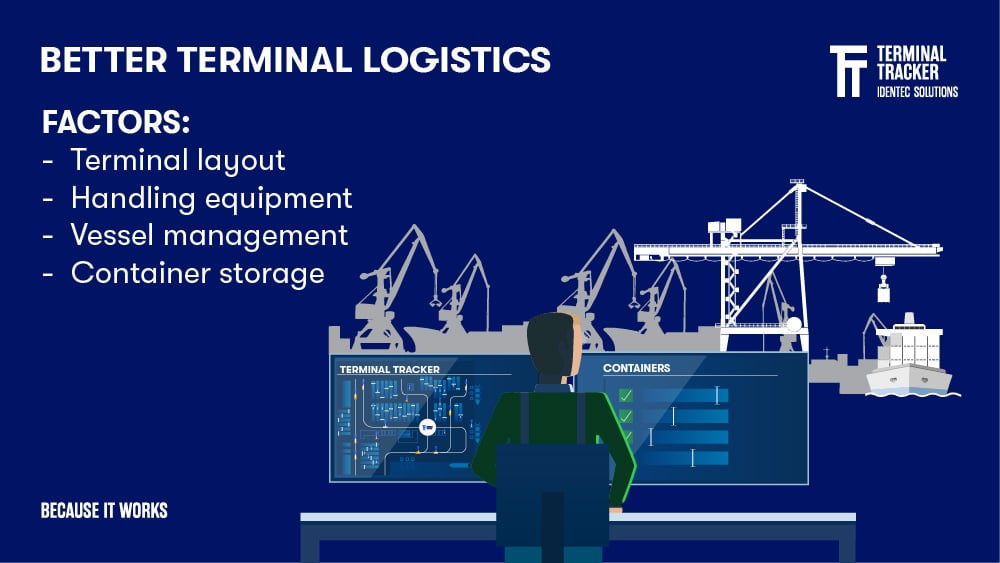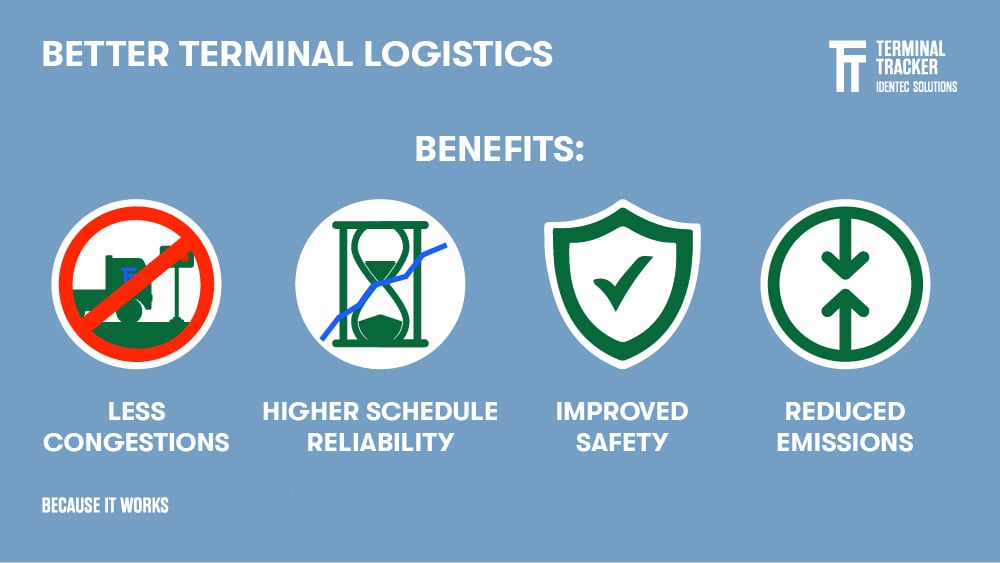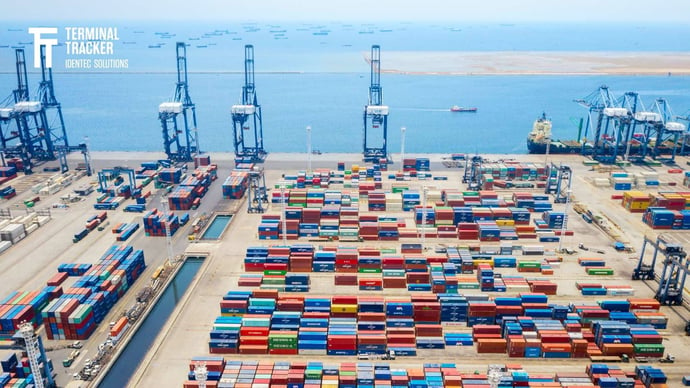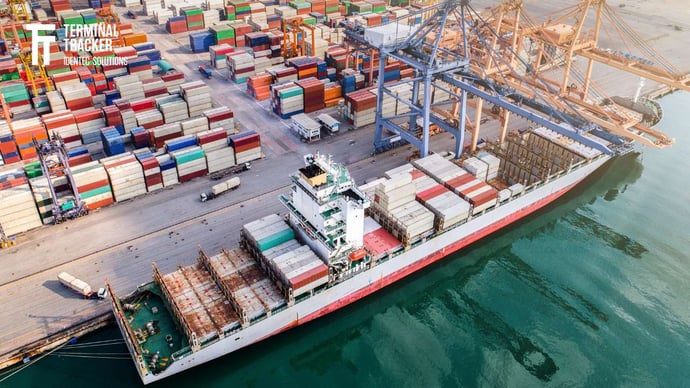Reducing Costs with Better Port Terminal Operations
| Written by Mark Buzinkay
Port terminals are an essential part of the supply chain for many businesses, and optimizing their logistics can help to improve efficiency and reduce costs. There are a number of factors to consider when optimizing port terminal operations, including the layout of the terminal, the location of critical facilities, the handling equipment, the management of vessels, and the storage and movement of containers within the terminal.

No video selected
Select a video type in the sidebar.
"Automated systems provide unparalleled precision and consistency, which reduces the risk of costly errors and damage to goods. This reliability is crucial for maintaining customer trust and reducing insurance premiums."
Elisa Rouhiainen, VP Sales Marine & Ports
What are Port terminals, and why are they important?
Port terminals are a vital part of the supply chain for many businesses. It is fair to say that maritime shipping is the backbone of world trade, as hard data estimates that 80-90% of all goods are shipped by sea. ("backbone of world trade").
A port terminal is a facility where cargo containers are transferred between different modes of transportation. There are maritime container terminals located inside a port and intermodal terminals located inland. Maritime container terminals transfer containers between ships and other modes of transport, while intermodal terminals transfer containers between different modes of transport, such as trains and trucks.
Container terminals are located inside or near ports, and the main activity at a container terminal is the transfer of containers from one mode of transport to another. Other port terminal operations can include container storage and value-added services such as cargo unit maintenance and repair. In some cases, container terminals also provide consolidation and deconsolidation services for cargo.
In summary, container terminals provide a quick, safe, and efficient way to handle goods by standardizing the containers used. This allows for the use of gantry cranes, forklifts, and reach stackers to transfer containers between different modes of transport.
What factors should you consider when optimizing port terminal operations?
The size of a port terminal's yard is the primary determinant of how many containers the facility can host at any given time, the biggest is the port of Shanghai, exceeding 50M TEU in 2024 for the first time (3). A terminal's maritime, rail, and road connectivity are also key factors in its efficiency and capacity. If a terminal has good access to ship, train, and truck services, it will be able to move more containers through its facilities. Finally, the type and number of cranes and other handling equipment a terminal has will also affect its ability to load and unload containers efficiently.
Optimizing port terminal operations can help to improve efficiency and reduce costs. There are a number of factors to consider when optimizing container terminal logistics, including:
- The layout of the terminal and the location of key facilities such as gates, berths, and cranes
- The handling equipment available and how it is used
- The management of vessel arrivals and departures
- The storage and movement of containers within the terminal
By considering each of these factors and making improvements where possible, ports can optimize their terminal operations and improve their overall supply chain performance. Let's have a closer look at them further below, but first:
What are the benefits of optimizing Your Port terminal Operations?
In general, port efficiency has a tremendous impact on all who interact with this hub of trade activity. Currently, one of the biggest issues with port efficiency is port congestion. These congestions, in turn, further stress supply chains all over the world, posing a ripple effect on many industries. Optimized, efficient container terminal logistics won't eradicate this problem but greatly help to mitigate it.
Congestions cause supply chain disruptions, container shortages and severe delays at some of the world's busiest ports. As a result, ports around the world may be forced to stop accepting import/export orders. But reliability may be ports and shipping lines' most important performance factor as trade routes operate on tight schedules. Therefore, benefits in improved efficiency can't be measured in costs alone, but most importantly in time increasing competitiveness.
In addition, optimized logistics can help to improve customer satisfaction by providing faster and more reliable service. Another benefit is that it can help to reduce environmental impact by reducing emissions and waste. Finally, optimized logistics can also help to improve port safety by reducing the risk of accidents. The most successful container terminals focus on reliability, speed of moving of containers, capacity and their interconnections with other transport modes.
Eventually, the storage and cargo movement processes in ports are fundamental parts of efficient logistics. These processes are vital to preserving the integrity of the products in the containers and promoting safety.

How can you make improvements to your Port terminal operations?
When it comes to maritime operations, experts identify maritime access as the component that has a massive impact on container terminal efficiency. It influences the average anchorage time (ships are waiting for an available berth) and the average ship turnaround time (the time it takes to service a vessel after it's docked). The impact of maritime access is immediately visible as it will limit the maximization of the produced output.
However, berth occupancy and turnaround time are just some indicators of port efficiency. An interlinked chain of factors - from maritime operations to terminal and hinterland operations- will most likely impact other elements of port terminal operations (like container handling). This includes:
- Crane performance is a crucial factor affecting the time a ship spends at a port.
- Moving containers in and out of the storage yard.
- Gate performance, including document processing and security inspections (average gate waiting time).
- Performance of rail loading/unloading equipment.
- Cargo transhipment performance is influenced by how long it takes trucks to enter the terminal and pick up or drop off cargo.
Noting that the most important factor in hinterland operations is the capacity for local roads connected to the port to handle related traffic, they cite street-level congestion as a major factor that impairs port performance.
Changing a container terminal's layout can dramatically decrease port operations' costs and emissions. Abu Aisha & others suggested a new layout for the Port of Montreal (Canada) that could show a reduction of 46,5% in the total transportation cost of the containers to their final destination and 21.6% in the emission. The proposed layout improved the sustainability of port activities by decreasing the distance between the berth and interface points as well as avoiding double handling.
With the increasing introduction of digital technologies to container terminals, managing operations at ports benefits from a faster flow of data between sensors, devices, equipment and software applications to enable the smart infrastructure driving ports to become state-of-the-art facilities of the future. As a result, digital technologies and increasing data exchange among all stakeholders yield higher gains in efficiency and predictability in ports (learn more about port terminal automation)
The first approach is to elevate container terminal logistics capabilities and include smarter job-promoting processes. Information systems with built-in real-time data feeds can now combine tightly coupled tactical and operational optimization models. With a focus on operational efficiency, TOS-enhancing solutions (like Terminal Tracker) address the problem of jointly solving integrated, interconnected tactical/operational planning and executing models for efficient container terminal logistics.
More: Interested in predictive maintenance?

FAQ
Which are the most meaningful Port Terminal Operations KPIs?
Throughput: Container throughput is a central key performance indicator (KPI) that indicates the total number of TEUs (Twenty-foot Equivalent Units) handled within a certain period of time and provides direct information about a terminal's capacity and productivity. Ship throughput measures the containers handled per ship call and thus helps assess the efficiency of cargo handling per ship.
Turnover Time: This key figure includes the turnaround times of ships, trucks and trains. It shows how much time is needed for handling and shows both the efficiency of port operations and the impact on schedules and congestion.
Equipment Utilisation: It measures the productivity of cranes, container handling equipment (CHE), and other vehicles. For example, container movements per hour are measured here, as is the time the equipment was in use.
Dwell Time: Dwell time indicates how long containers spend, on average, in the yard before being picked up or shipped. This affects the utilisation of storage space and container flow.
Capacity Utilisation: This measures how effectively the terminal uses its available space using the use of berth and storage space. High utilisation rates indicate efficient space management.
Operational Efficiency: This is assessed using metrics such as container handling efficiency and cost per move.
Service Reliability: Recording and monitoring data on punctuality and operational downtime are critical to avoid disruptions and thus maintain customer satisfaction.
Safety and Compliance: This includes information on accident rates and compliance with regulations for a safe working environment and legal operations. Likewise, environmental performance, such as emissions and energy consumption per movement, are recorded to track the fulfilment of sustainability efforts.
All of these metrics are critical to identify areas for improvement and optimise operations.
Takeaway
Container port efficiency has always been important to the maritime industry. In fact, it is one of the most important factors in determining a ship's operating costs. Nowadays, with the ever-growing size of container ships and the need for faster turnaround times, container port efficiency has become even more critical.
There are many ways to approach increasing container port efficiency and productivity. Some common methods include streamlining vessel operations, optimizing terminal layout and design, using information technology to its fullest potential, and automating certain terminal processes (read our post about the idea of a port position detection system).
The importance of container port efficiency cannot be understated. Not only does it save maritime companies money, but it also helps to reduce pollution and congestion in our world's ports. By increasing efficiency and productivity, we can make a real difference in the way our maritime industry operates.
If you want to learn more about how to upgrade your running terminal into a semi-automated terminal, continue reading this post about an automation project.
Dive deeper into one of our core topics and learn more about: Smart Port
Glossary
Berth occupancy refers to the percentage of time a berth is occupied by a vessel for loading or unloading operations. It's a key performance indicator for port efficiency, typically expressed as a ratio of actual berth usage time to total available time. Higher berth occupancy can indicate efficient port operations but may also lead to increased ship waiting times. Optimal berth occupancy varies based on the number of berths and terminal characteristics, generally ranging from 60-80% for multi-berth facilities. (4)
Port congestion occurs when a port has more ships waiting to load or unload cargo than it can efficiently handle. This results in vessels anchoring outside the port or drifting in designated areas, causing delays that can stretch from days to weeks. Factors contributing to congestion include high cargo volumes, limited port capacity, labour shortages, inefficient operations, and unforeseen events. Port congestion disrupts shipping schedules, increases costs, and impacts global supply chains. (5)
Sources:
(1) Kemme, Nils. (2013). Container-Terminal Logistics. 10.1007/978-3-7908-2885-6_2.
(2) Abu Aisha, Tareq & Ouhimmou, Mustapha & Paquet, Marc. (2020). Optimization of Container Terminal Layouts in the Seaport—Case of Port of Montreal. Sustainability. 12. 1165. 10.3390/su12031165.
(3) https://en.portshanghai.com.cn/LatestNews/4310.jhtml
(4) Port Management and Operations by Maria G. Burns, CRC Press, 2018
(5) Maritime Logistics: A Guide to Contemporary Shipping and Port Management by Dong-Wook Song and Photis Panayides, Kogan Page, 2015
Note: This article was updated on the 21st of January 2025

Author
Mark Buzinkay, Head of Marketing
Mark Buzinkay holds a PhD in Virtual Anthropology, a Master in Business Administration (Telecommunications Mgmt), a Master of Science in Information Management and a Master of Arts in History, Sociology and Philosophy. Mark spent most of his professional career developing and creating business ideas - from a marketing, organisational and process point of view. He is fascinated by the digital transformation of industries, especially manufacturing and logistics. Mark writes mainly about Industry 4.0, maritime logistics, process and change management, innovations onshore and offshore, and the digital transformation in general.




